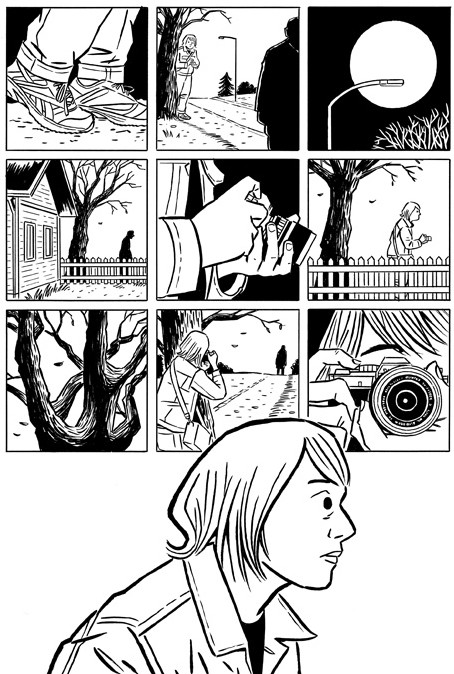Picture this
9 April 2015 | Articles
It’s impossible to put Finnish graphic novels into one bottle and glue a clear label on to the outside, writes Heikki Jokinen. Finnish graphic novels are too varied in both graphics and narrative – what unites them is their individuality. Here is a selection of the Finnish graphic novels published in 2014
Graphic novels are a combination of image and word in which both carry the story. Their importance can vary very freely. Sometimes the narrative may progress through the force of words alone, sometimes through pictures. The image can be used in very different ways, and that is exactly what Finnish artists do.
In many countries graphic novels share some common style or mainstream in which artists aim to place themselves. In recent years an autobiographical approach has been popular all over the worlds in graphic novels as well as many other art forms. This may sometimes have led to a narrowing of content as the perspective concentrates on one person’s experience. Often the visual form has been felt to be less important, and clearly subservient to the text. This, in turn, has sometimes even led to deliberately clumsy graphic expression.
This is not the case in Finland: graphic diversity lies at the heart of Finnish graphic novels. Appreciation of a fluent line and competent drawing is high. The content of the work embraces everything possible between earth and sky.
Finnish graphic novels are indeed surprisingly well-known and respected internationally precisely for the diversity of their content and their visual mastery.
Life on the block

‘Shall we go and look at our new house? / Yeah. / Did you move house? / Yeah, to one without a floor. / At least you have head-space! / This is where the mould was. / Oh dear!’. Tiitu Takalo, Minä, Mikko ja Annikki (‘Me, Mikko and Annikki’, Suuri kurpitsa).
Minä, Mikko ja Annikki (‘Me, Mikko and Annikki’) interleaves the past and present of a block of wooden buildings in Tampere. The stories by Tiitu Takalo (born 1976) are wound round the Annikki block, left standing after the demolition of the traditional factory town.
The main thrust of the plot is autobiographical. The artist dreams of moving, with her partner, into the Annikki block, and her dream comes true. The story is an hommage to perseverance, work and collective action on behalf of the block.
At the same time the book tells of the history, reality and life of the working people of Tampere. The city grows and life changes, but progressive steps are still taken together through collective struggle.
Although the book deals with themes of the progress of history, the changing city and factors that affect it, the main focus remains on people and everyday life. The images are full of people and their speech, their hopes and their desires.
Tiitu Takalo is one of the most gifted graphic novel artists of her generation. Her line is vivid and supple, tender but expressive. It has power but no bluster. The broken colours make reading a pleasant experience.
Most of Takalo’s earlier words have been sympathetic descriptions of the situations of young women. One must clear a space for oneself, particularly if one wishes to diverge from the mainstream. Takalo has something to say, and she says it.
The same is true of this book. The story proceeds in sections, and in some of them the desire to communicate is particularly strong, as in the critique of consumerism. The result is a little fragmented, but the entire narrative rises from the same world-view and creates a coherent work.
Minä, Mikko ja Annikki pays tribute in its title to a 1967 novel by Hannu Salama – Minä, Olli ja Orvokki (‘Me, Olli and Orvokki’), and thereby to the literary tradition of the city of Tampere. In addition, the book is made, published and even printed in Tampere.
Nevertheless it is universal in its content: human relationships, the diversity of life, the meaning of collaborative work, the changing world and those small, personal, human-sized hopes and wishes.
Controlled self-indulgence

‘… Is this going to last long? … I have to destroy Leningrad?’. Heikki Paakkanen, Saksa-Suomi im Bunde (‘Germany-Finland as allies’, Zum Teufel)
Heikki Paakkanen (born 1949) seems very much at home in the dustbin of history. Saksa-Suomi im Bunde (‘Germany-Finland as allies’) continues a series of works, Sissi ja siviilipalvelushenkilö (‘The commando and the conscientious objector’) in which he turns his gaze on different countries in turn. In earlier albums he has considered France, Sweden and Russia. His subject this time is Finland’s alliance with Germany during the Second World War.
Paakkanen’s work combines a controlled coarseness with a carnivalism that never slips into tastelessness. This is achieved by Paakkanen’s anachronistic and anarchic conservatism and his all-pervading humour. He delights in the memories, objects and customs of past times, but is at the same time deeply suspicious of all authority.
All of this is combined with careful background studies. Saksa-Suomi im Bunde presents us with a torrent of the most astonishing details about the alliance between the two countries or the activities of the Nazis, but they all turn out to be valid.
The reader’s sense of history is aided by an unusual feature: box features by the historian Markku Jokisipilä are interleaved with the graphic narrative. This strategy is surprisingly readable.
The book’s central theme emerges as the control of the past, the Vergangenheitsbewältigung much discussed in Germany. Encountering the past with open eyes aids survival in the present. The same vision is repeated in many of Paakkanen’s work; he enjoys the ability to dive into different periods or places to challenge our deep-rooted modes of thought.
Paakanen’s visual thinking is dominated by horror vacui, the fear of empty spaces. His strong line creates a baroque graphic novel style. He specialises particularly in drawing details, machines and equipment.
Midsummer smiling

‘A wide selection of teas. / Well let’s go there then. / Isn’t that the warm aroma of jasmine? / And juicy fillings in the rolls. / Even the background jazz flows pleasantly. / But? / Is your mug already empty? / It was certainly a relief to take a turn around the open-plan office of those young urban innovators!’. Pauli Kallio & Christer Nuutinen, Ihan pienet juhlat (‘A really small party’, Hans Nissen)
Ihan pienet juhlat (‘A really small party’) is a story about young adults: they begin to makes their lives, buy apartments, children are born. The narrow opinions of youth ease even if world-views stay the same.
The Kramppeja ja nyrjähdyksiä (‘Cramps and sprains’) series, which began in 1991, depicts a permanent cast of characters who grow older with time. The narrative proceeds one page at a time, as the series is published weekly in Suomen Kuvalehti (‘The Finnish illustrated magazine’).
There have been many illustrators along the way. The current artist, Christer Nuutinen (born 1971), was also the first. Ihan pienet juhlat is the eleventh published album of the series.
Kramppeja ja nyrjähdyksiä is above all the creation of its writer, Pauli Kallio (born 1960). His interpretations of the way of the world, music, football, human relationships or the wonders of everyday life support the narrative and link it into a long-running whole.
There is no great drama about the series; its events fit within our experience of everyday life. Kallio writes a modest story seasoned with suitably modest dreams. This is the root of the charm of the narrative: life can be beautiful if you are able to see it that way. The narrative is loosely linked to current events. It comments on the way of the world, but not in the manner of a newspaper. The comics are autobiographical in the sense that they could have happened, if not to Kallio himself, then at any rate to people like him.
In his images, Christer Nuutinen is a builder of dream worlds and a believer in the delicate beauty of humanity. It is possible to linger in the curved lines of his drawings, picking out cotton-wool city scenes with birds and clouds. This makes the series light, like a midsummer smile.
A man’s way
Köyhän miehen Jerusalem (‘A poor man’s Jerusalem’) is a return by Ville Ranta (born 1978) to autobiographical graphic novels after his ambitious depictions of great men, Kajaani (2008) and Kyllä eikä ei (‘Yes, not no’, 2013). Here Ranta ponders parenthood, the durability of the creative talent and growing older. A new child is on the way with a new partner, and work is not going well.
The artist’s musings are bleak: the move of his children from an earlier relationship is hard, but on the other hand he felt he was often unable to be fully present for them. A new child brings new responsibilities, which are frightening. Exhaustion and the flagging of the will to work overwhelm him. His thoughts and observations are searing. The narrative is merciless, not flinching at even the gloomiest of thoughts. The experience of birth, for example, is compared to slaughtering a lamb. The clearing of thought in an Italian bar at the end of the book, however, opens a possibility.
The swift drawing line of the work may seem sloppy. It is not: this is the result of a mastery of simplification and choice developed over hundreds of kilometres of drawn line. The drawings do not operate according to any simple code: it has tenderness, a sketch-like quality or weight, according to the situation. Köyhän miehen Jerusalem is an interesting and skillfully made interim report on the questions and fears of the creative mind and the balance between family and work from the male perspective.

‘Dad! / I’m not your dad – yet! / But you will be soon! You’re going to be a socially respected person, the responsible parent of a young child… / … and did you know, I’ve developed… / Not bullshit, but commitment! Again!’ Ville Ranta, Köyhän miehen Jerusalem (‘A poor man’s Jerusalem’, Asema.
The importance of the story
Although the autobiographical approach has been strongly evident in many art forms, graphic novels included, in recent years, it now seems to have made space for other forms of narrative: satire, high drama and social criticism are all strongly present.
This diversity appears to be particularly attractive to foreign publishers. In the past decade, more than one hundred translations of Finnish graphic novels have been published – which, for a small genre in a small language, is not a bad result.
Heading the translation list in graphic novels, as well as literature as a whole, is Tove Jansson. (1914-2001) The Moomintroll comic strip she created in 1954 experienced a second coming in 2006 when the Canadian publisher Drawn & Quarterly published its stylish compendium albums in 2006 for the North American market. The series had been previously unknown there, but received positive reviews and achieved good sales. These publications spawned new editions in many different languages, including the promised land of graphic novels, France, where the Moomin comics were also almost unheard-of.
But the popularity of Finnish graphic novels abroad is not limited to the Moomins. There are dozens of translated graphic novel artists. This demonstrates the good reputation of Finnish graphic novels abroad, and there is a constant appetite for new authors too. Interest is centred around artistically ambitious but often small-circulation works.
This is changing. The monumental Näkymättömät kädet (‘Invisible hands’) by Ville Tietäväinen (born 1970) appeared in 2014 in Germany, attracting extensive and serious reviews and the attention of the mass media. Its story of the tough fate of a north African immigrant in prosperous Europe is universal. The book’s rights have been sold to Egypt and it has also been published in France.
Another work resting on skilful drawing is Perkeros (2013) by J.P. Ahonen and K.P. Alare (both born in 1981). It has either been published or is imminent in French, English, Italian, Spanish and German, from important publishers. The complex story, about the founding of a heavy metal band, moves between everyday reality and fantasy. The drawing is technically skilful and painstakingly detailed.
Ahonen’s Villimpi pohjola (‘The wilder north’), on the other hand, depicts students in the stressful days of finals. Lapsus (‘Lapse’) is the fifth album of the series. Here Ahonen’s attention to finish is fully realised. He knows the visual grammar of graphic novels and is able to use it effectively; even the details form an important part of the narrative, bringing it a new level.
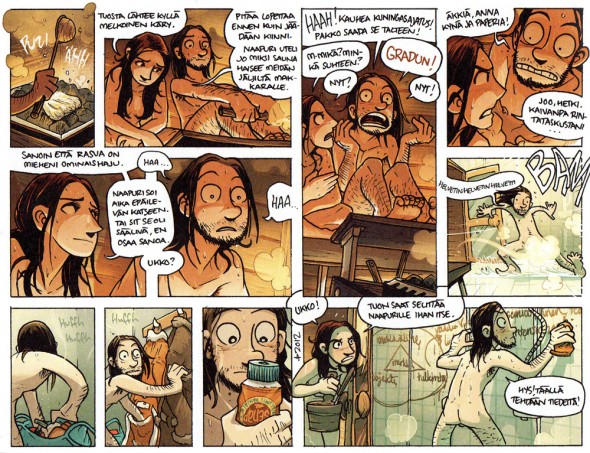
‘There’s certainly a burning smell coming off that! / We’d better stop before we’re caught. / Our neighbour’s already been wondering why the sauna smells of sausage after we’ve used it. / I said fat was my man’s characteristic smell. / Our neighbour gave us a doubtful look. Or then a pitying one, it’s hard to say. / Old man? / Haa… Haa…/ Haah! A terrible thought! I need to write it down! / Wh-what? What’s it about? / My dissertation! / Now! Now! / Quick, give me a pen and paper! / Yeah, just a minute, let me get it out of my breast pocket! / Damndamndamn / Old man! / You can explain that one to our neighbour yourself. / Ssshhh! I’m making science!’.
J.P. Ahonen, Lapsus (‘Lapse’, Arktinen Banaani)
On the tracks of identity
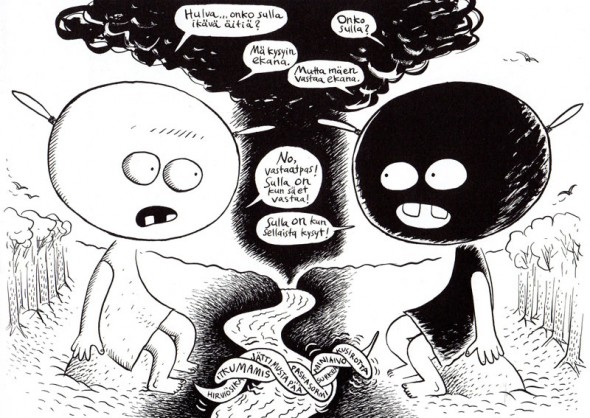
‘Hulva… do you miss your mum? / Do you? / I asked first. / But I’m not going to answer first. / Well, go on, answer! You’re silly if you don’t! / You’re silly if you ask a question like that!’. Kati Kovács, Deltan kaksoset (‘The delta twins’, WSOY)
The Rome-based Finnish artist Kati Kovács (born 1963) is known for her carnival-like, surrealist images and stories. Her female characters are strong, seeking their own way, but at the same time honestly contradictory. Kovács’s line is unpredictable, plaful and, where appropriate, erotically carnal.
Deltan kaksoset (‘The delta twins’) turns a new page in Kovács’s work. The twins Hylva and Sylfa are seeking their father, but realism is far form the story: it is an immense mix of the fantastic, the grotesque, the absurd and the fairy tale. The theme is a familiar one: the search for one’s own identity and the attempt to reach a whole sense of self.
In their new works, three men born in the 1970s – Mika Lietzén (born 1974), Petteri Tikkanen (born 1975) and Marko Turunen (born 1973) continue to plough their furrows. Mika Lietzén’s comics are generally like plays, even chamber plays. Their rhythm is steady and the images those of everyday realism, with a minimalism evident only in the human figures. He does not underline his stories; he demands that his readers understand for themselves.
1986 plumbs the world of young people. The boys of a small town indulge in role-play games and read horror stories. Reality, however, turns out to be more incredible than the supernatural worlds they long for. 1986 is not as minimal with respect to its characters as Lietzén’s earlier work. Its layout follows that of traditional comic magazines, as if as a reminder of the reading habits of the time it depicts.
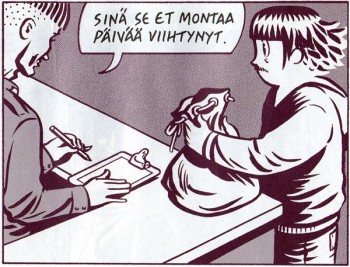
‘You didn’t exactly last a long time.’ Petteri Tikkanen, Armeija (‘Army’, Like).
Armeija (‘Army’) is Petteri Tikkanen’s seventh book about the childhood and youth of friends Eero and Kanerva. Tikkanen depicts the pain of growing up tenderly and skillfully: the death of grandparents, awakening sexuality, peer pressure and the search for oneself.
Change continues: Eero is going into the army. There are pressures from all sides as friends and relatives have clear ideas as to what the young man should do with his life.
Tikkanen’s brush paints a rounded, steady picture. His expression is restrained, but strongly atmospheric. Alternation between close-ups and panoramas brings a certain filmic quality to the narrative.
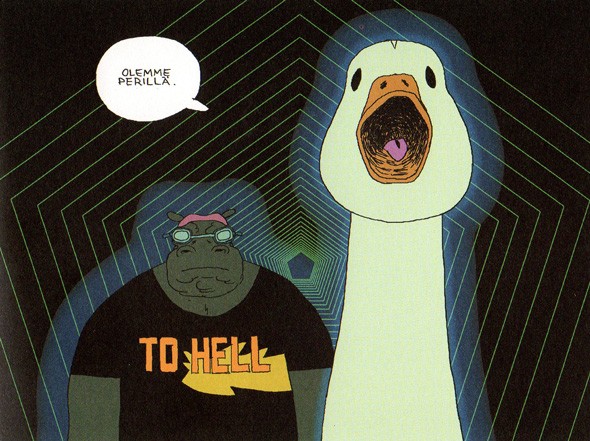
‘We’re there.’ Marko Turunen & Mika Jurva, Hanhenmarssia e-mollissa (‘Goose-step in E minor’, Daada).
Hanhenmarssia e-mollissa (‘Goose-step in E minor’) is based on a manuscript written in his teens on which Marko Turunen recently decided to base a graphic novel. Strongly influenced by the French comic artist Moebius (1938-2912), the story does not dazzle, but the work demonstrates once more Turunen’s extraordinary skill as a maker of images. His graphic novels have indeed been translated into many languages.
Turunen is able to combine many disparate elements into a picture, nevertheless achieving a strong emotional charge and atmosphere. When the images are combined with a proper story, the result is at its best magnificent, as in the touching book Marko Turusen elämä (‘The life of Marko Turunen’, 2013).
Translated by Hildi Hawkins
J.P. Ahonen, Lapsus (‘Lapse’, Arktinen Banaani), 96p.
Pauli Kallio & Christer Nuutinen, Ihan pienet juhlat (‘A really small party’, Hans Nissen), 112p.
Kati Kovács, Deltan kaksoset (‘The delta twins’, WSOY), 78p.
Mika Lietzén, 1986 (Asema), 32p.
Heikki Paakkanen, Saksa-Suomi im Bunde (‘Germany-Finland as allies’, Zum Teufel), 57p.
Ville Ranta, Köyhän miehen Jerusalem (‘A poor man’s Jerusalem’, Asema, 225p.
Tiitu Takalo, Minä, Mikko ja Annikki (‘Me, Mikko and Annikki’, Suuri kurpitsa), 247p.
Petteri Tikkanen, Armeija (‘Army’, Like), 48p.
Marko Turunen & Mika Jurva, Hanhenmarssia e-mollissa (‘Goose-step in E minor’, Daada), 160p.
Tags: comics, graphic novel
No comments for this entry yet

